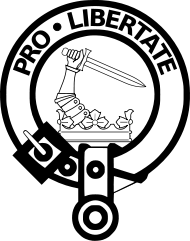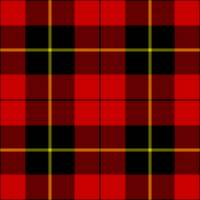Clan Wallace: Difference between revisions
Jlwallace1 (talk | contribs) m →Septs: removed citation needed - fact ~~~~ |
Jlwallace1 (talk | contribs) m Removed Verifications needed ~~~~ |
||
| Line 1: | Line 1: | ||
{{Refimprove|talk=y|date=January 2009}} |
|||
{{Infobox Clan |
{{Infobox Clan |
||
Revision as of 17:40, 17 June 2010
| Clan Wallace | |
|---|---|
| Uallas{[1]} | |
 Crest: Issuant from a crest coronet of four (three visible) strawberry leaves Or, a dexter arm vambraced, the hand brandishing a sword all Proper | |
| Motto | Pro liberate |
| Profile | |
| Region | Lowlands |
| District | Strathclyde |
| Plant badge | A sprig of oak fructed Proper |
| Chief | |
 | |
| Ian Francis Wallace of that Ilk | |
| Chief of the Name and Arms of Wallace | |
The Clan Wallace is a Lowland family.
Origins of the clan
The Wallace family first came to Scotland with a Norman family in the 11th century.[2] King David was eager to extend the benefits of Norman influence and gave grants to the nobles of the south. Among them was Walter Fitzallan, who the Scottish king appointed his Steward in 1136.[2] One of Fitzallan's followers was Richard Wallace from Oswestry who came north to try and improve his fortunes.[2] Oswestry is on the Welsh border so it is possible that the name Wallace may be a corruption of Le Waleis meaning the "Welshman".[2]
Lord Fitzallan received from King David lands in Ayrshire and so it was here that his follower Richard Wallace settled.[2] Richard Wallace was granted his own estate in Kyle, where it is claimed that his name Richard is still remembered in the placename of the village of Riccarton.[2]

While tradition claims Sir Malcolm Wallace of Elderslie as the father of three sons, Malcolm, John, and William Wallace, the seal of William Wallace, rediscovered in 1999, identifies William as the son of Alan Wallace of Ayrshire, who appears in the Ragman Roll of 1296 as "crown tenant of Ayrshire". Dr. Fiona Watson in "A Report into Sir William Wallace's connections with Ayrshire", published in March 1999, reassesses the early life of William Wallace and concludes, "Sir William Wallace was a younger son of Alan Wallace, a crown tenant in Ayrshire".
Wars of Scottish Independence
There is no evidence to support the tale that in his early years William Wallace and his mother had to take refuge near Dunipace from the English because they refused to pay homage to King Edward I. While Wallace was still young he became the leader of a company of patriots who used harassing tactics against the English and won the support of many Scottish nobles. Wallace's military genius made him "hated and feared" by King Edward I of England.
During the Wars of Scottish Independence William Wallace and Andrew de Moray won a great and stunning victory at the Battle of Stirling Bridge in 1297. Wallace was also in command at the Battle of Falkirk (1298), but there he was defeated. Unfortunately for the Scots, Wallace was eventually captured at Robroyson near Glasgow and delivered to Edward Longshanks of England by a senior Scottish law officer - Sir John Mentieth. Wallace was subjected to a mock trial, in which he was found guilty of treason and brutally hanged, drawn, and quartered at Smithfield, London in 1305.

Border wars
During the centuries that followed, the Wallace family continued to leave its marks, cultural and political, on Scotland and on Europe. In the 15th century, General John Wallace commanded Scotland's armies to victory over England at the Battle of Sark. Among those who joined him were the forces of George Douglas from the powerful Douglas family.
17th century and civil war
The Wallaces of Cragie from who the senior branch of the clan is descended obtained their estate during the early 17th century, through the marriage to the heiress of Sir John Lindsay of Cragie.[2]
A contemporary Wallace, James Wallace served as a Captain under General Robert Monro when he occupied Huntly Castle of the Clan Gordon in 1640. Another contemporary Wallace, Sir Hugh Wallace, celebrated Cavalier, raised the regiment for King Charles Stuart during the Puritan revolution of Oliver Cromwell.
In 1669 Hugh Wallace of Cragie was one of the Scottish nobility who was created a Baron of Nova Scotia under Sir William Alexander of Menstreis's scheme to promote that part of Canada as a Scottish colony.[2]
Also in the 17th century, mathematician John Wallis was the first to deal with the concept of infinity mathematically and paved the way for the development of calculus and binomial theorem in his 1657 work Arithmetica Infintorum.
Wallaces in the 19th century

In the 19th century, eminent naturalist and author, Alfred Russel Wallace, developed his own theories on evolution, based on his studies of flora and fauna in South America and in the East Indies, independently of Charles Darwin. Both theories were published simultaneously in 1858. Thomas Wallace served as the vice-president of the British Board of Trade, who in 1821, cut the duties long imposed on Baltic timber; the act herald the end of the mercantile system that had existed since England had first established colonies. Sociologist Graham Wallis was an early leader of the Fabian Society, along with George Bernard Shaw, an organization which promoted the peaceful and democratic "permeation of (British) politics with socialist and collectivist ideas." Sir Richard Wallace was a great collector of painting, sculpture and furniture; primarily 18th century French. He bequeathed his collections to the people of Britain; upon his death in 1897 they became known as the National Wallace Collection.

Memorial
At Stirling on top of the Abbey Craig stands the nation's William Wallace Monument built in 1896. In 1814 a huge statue was erected to his memory near Dryburgh Abbey in the Scottish Borders. The Wallaces of Craigie, of Cessnock, of Kelly and of Cairnhill are all descended from the original family of Riccarton in Ayrshire.
Chief
Ian Francis Wallace of that Ilk, Chief of the Name and Arms of Wallace.[3][4]
Septs
There are no sept families of Clan Wallace, just Wallace. This is the decision of the current clan chief.
Some of the many ways of spelling the name attributed to the family of:
Most common Wallace - and second most common: Wallis
Walla, Wallais, Wallace, Wallice, Wallang, Wallass, Wallayis, Wallays, Walleis, Wallensis, Walles, Walleyis, Walleys, Walli, Wallis Walls, Wallyis, Wallys, Walois,Walys
- Waces, Wal’, Walace, Walais, Walans, Walas, Walays, Wale, Waleis, Walency, Walens, Walense, Walensen, Walensi, Walensis, Wales, Waless, Waleys, Waleyss
- Valance, Valensis, Valeyns, Vallace, Vallance, Valles, Valleyis, Vallibus (Not Vallibus, which has always signified the family of de Vaux or Vaus)
- Uallas (the Scots Gaelic)
- Gadhel, Galeis, Galeius, Gales, Galeys, Galleius, Grieve, Galleius, Galles, Galles, Gallia, Gallois, Gaul, Gweddol
Branches
Leading branches of the Clan Wallace in Scotland include the Wallaces of Cragie, the Wallaces of Cairnhill, the Wallaces of Cessrock, the Wallaces of Elderslie, the Wallaces of Kelly and the Wallaces of Riccarton.[2]
Clan Profile
- Arms of the Chiefs: Gules, a Lion rampant argent, armed azure, a Bordure counter company azure and argent. [5]
- Crest Badge: Issuant from a crest coronet of four (three visible) strawberry leaves Or, a dexter arm vambraced, the hand brandishing a sword all Proper.[6]
- Natural Badge: A sprig of oak fructed Proper.[7]
- Motto: Pro Libertate - "For liberty".[8]
- Gaelic Name: Uallas
- Tartans: Red Wallace, Green Wallace, Blue Wallace; each available in modern, ancient and weathered hues and all invented in relatively recent times.
See also
References
- ^ http://en.wikipedia.org/wiki/Scottish_Gaelic
- ^ a b c d e f g h i "The Wallaces”. By Bill Fyfe Hendrie. Lang Syne Publishers Ltd. 1997. ISBN: 1852170581.
- ^ http://www.burkes-peerage.net/familyhomepage.aspx?FID=0&FN=WALLACEOFTHATILK burkes-peerage.net
- ^ http://www.clanchiefs.org/p/chiefs.html Standing Council of Scottish Chiefs
- ^ http://en.wikipedia.org/wiki/Lord_Lyon_King_of_Arms
- ^ "electricscotland.com".
- ^ "clanwallace.org".
- ^ "electricscotland.com".
